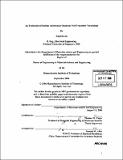An evaluation of indium antimonide quantum well transistor technology
Author(s)
Liu, Jingwei, M. Eng. Massachusetts Institute of Technology
DownloadFull printable version (23.20Mb)
Alternative title
Evaluation of InSb quantum well transistor technology
Other Contributors
Massachusetts Institute of Technology. Dept. of Materials Science and Engineering.
Advisor
Thomas W. Eagar.
Terms of use
Metadata
Show full item recordAbstract
Motivated by the super high electron mobility of Indium Antimonide (InSb), researchers have seen great potential to use this new material in high switching speed and low power transistors. In Dec, 2005, Intel and its partner, QinetiQ, Ltd, announced 85nm gate length enhancement and depletion mode InSb quantum well transistors. Such transistors can operate as high as 305GHz and power consumption is reduced by a factor of 10. In this thesis, the emerging InSb transistor technology is discussed in details. Given its superior performance, it may complement silicon transistor to extend Moore's law in the next decade. The prospect of InSb transistor is also compared with other nanotechnology transistors, such as carbon nanotube and silicon nanowire. Several potential markets are figured out, namely, microprocessor, low noise amplifier and millimeter wave device. Related patents are evaluated. It is found that most of the patents are held by Intel's partner, QinetiQ Ltd. and thus patents issue would not block the launch of products. A joint venture or strategy alliance model is proposed to reduce the risk of investment. In addition, a cost model is presented at the end. It is concluded that cheap silicon substrate and large enough production scale are two crucial factors for the commercialization success of InSb transistor technology.
Description
Thesis (M. Eng.)--Massachusetts Institute of Technology, Dept. of Materials Science and Engineering, 2006. Includes bibliographical references (leaves 98-102).
Date issued
2006Department
Massachusetts Institute of Technology. Department of Materials Science and EngineeringPublisher
Massachusetts Institute of Technology
Keywords
Materials Science and Engineering.